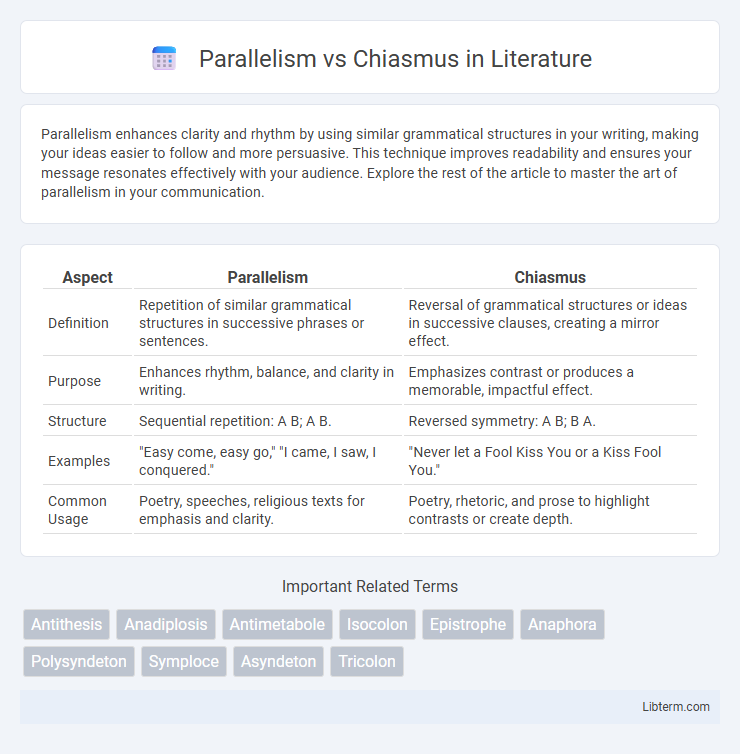Parallelism enhances clarity and rhythm by using similar grammatical structures in your writing, making your ideas easier to follow and more persuasive. This technique improves readability and ensures your message resonates effectively with your audience. Explore the rest of the article to master the art of parallelism in your communication.
Table of Comparison
| Aspect | Parallelism | Chiasmus |
|---|---|---|
| Definition | Repetition of similar grammatical structures in successive phrases or sentences. | Reversal of grammatical structures or ideas in successive clauses, creating a mirror effect. |
| Purpose | Enhances rhythm, balance, and clarity in writing. | Emphasizes contrast or produces a memorable, impactful effect. |
| Structure | Sequential repetition: A B; A B. | Reversed symmetry: A B; B A. |
| Examples | "Easy come, easy go," "I came, I saw, I conquered." | "Never let a Fool Kiss You or a Kiss Fool You." |
| Common Usage | Poetry, speeches, religious texts for emphasis and clarity. | Poetry, rhetoric, and prose to highlight contrasts or create depth. |
Introduction to Parallelism and Chiasmus
Parallelism involves the repetition of similar grammatical structures or phrases to create rhythm and enhance clarity, often used in speeches and literature. Chiasmus is a specific form of parallelism where elements are mirrored or inverted in a sequence, creating a crisscross pattern that emphasizes contrast or balance. Both techniques serve rhetorical and stylistic purposes, enriching language by reinforcing ideas through structured repetition.
Defining Parallelism in Language
Parallelism in language is a rhetorical device where parts of a sentence or multiple sentences are structured similarly to create balance and rhythm. This technique involves using the same grammatical form, such as repeated phrases, clauses, or sentence structures, enhancing clarity and emphasizing ideas. Parallelism strengthens writing by making it more persuasive, memorable, and easier to follow.
Understanding Chiasmus: Structure and Examples
Chiasmus is a rhetorical device characterized by the inversion of parallel structures in successive clauses, creating a mirror-like arrangement (ABBA) that enhances emphasis and memorability. Unlike straightforward parallelism, which repeats similar grammatical patterns (ABAB), chiasmus reverses the order of words or concepts to draw attention to the relationship between ideas. Classic examples include John F. Kennedy's phrase "Ask not what your country can do for you--ask what you can do for your country," illustrating its powerful syntactic symmetry and persuasive impact.
Historical Origins of Parallelism and Chiasmus
Parallelism, an ancient rhetorical device rooted in Hebrew poetry and classical Greek literature, emphasizes symmetry through the repetition of grammatical structures to enhance clarity and impact. Chiasmus, originating in classical Greek rhetoric and extensively used in biblical texts, involves a mirrored, inverted structure (ABBA) to create a memorable, artistic effect and highlight contrasts or connections. Both techniques reflect early linguistic efforts to organize thought and emphasize key ideas in oral and written traditions.
Comparative Analysis: Parallelism vs Chiasmus
Parallelism and chiasmus both utilize syntactic structures to create emphasis and rhythm, but parallelism repeats similar grammatical patterns while chiasmus inverts them to produce contrasting or mirrored effects. In parallelism, phrases like "She likes reading, writing, and jogging" maintain consistent structure, whereas chiasmus rearranges elements as in "Never let a Fool Kiss You or a Kiss Fool You," highlighting reversal and balance. The comparative analysis reveals parallelism's straightforward reinforcement versus chiasmus' more complex, artful symmetry that often enhances rhetorical impact.
Functions and Effects in Rhetoric
Parallelism and chiasmus both enhance rhetorical impact by structuring ideas for clarity and emphasis; parallelism uses repeated grammatical forms to create rhythm and reinforce concepts, making arguments more memorable. Chiasmus reverses the order of words or phrases in successive clauses, creating a mirror effect that highlights contrast or deepens meaning through symmetrical balance. These devices function to engage audiences emotionally and intellectually, facilitating persuasion and enriching the texture of language in speeches and writing.
Usage in Classical and Modern Literature
Parallelism, characterized by the repetition of similar grammatical structures, is extensively used in classical literature such as Homer's epics and Shakespeare's plays to enhance rhythm and emphasize key themes. Chiasmus, involving the inversion of phrases or concepts, appears prominently in classical rhetoric and biblical texts, creating memorable expressions and reinforcing contrasts. Modern literature employs both devices to evoke classical elegance or contemporary irony, with parallelism often driving narrative flow and chiasmus highlighting paradoxes or moral complexities.
Recognizing Parallelism and Chiasmus in Famous Speeches
Parallelism in famous speeches emphasizes repetition of grammatical structures to create rhythm and reinforce key ideas, as seen in Martin Luther King Jr.'s "I Have a Dream" speech. Chiasmus, involving a reversal of phrase order, adds emphasis and memorability, exemplified by John F. Kennedy's "Ask not what your country can do for you--ask what you can do for your country." Recognizing these rhetorical devices enhances understanding of speechcraft and the persuasive power embedded in iconic oratory moments.
Practical Guidelines: How to Employ Each Device
Use parallelism to create rhythm and clarity by repeating grammatical structures in successive phrases or sentences, enhancing readability and emphasis. Apply chiasmus to highlight contrast or create memorable expressions by reversing the order of words or ideas in parallel clauses, making key points more striking. Balance both devices by choosing parallelism for reinforcing ideas and chiasmus for showcasing contrasts or clever twists in speech or writing.
Conclusion: Choosing the Right Device for Impact
Parallelism enhances clarity and rhythm by repeating similar grammatical structures, making arguments memorable and persuasive. Chiasmus creates a striking contrast through inverted structures, emphasizing key ideas and deepening emotional impact. Selecting between parallelism and chiasmus depends on whether clarity or dramatic effect best serves the communication goal, ensuring maximum influence on the audience.
Parallelism Infographic

 libterm.com
libterm.com